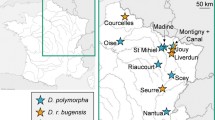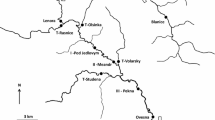Abstract
Caged freshwater mussels Dreissena polymorpha were transplanted for three months at ten sites along the Wiltz River in the North of the Grand-Duchy of Luxembourg. Three different biological parameters were employed to assess the physiological condition of the molluscs after 27, 51, 75, and 90 days of exposure: mortality, reattachment success, and dry weight. Besides the introduced zebra mussels, translocated aquatic mosses, Fontinalis antipyretica, were employed as a second trace metal indicator, though with a different experimental design. The moss tufts were replaced in toto every time the mussels were sampled in order to separately monitor temporal changes in the water metal levels. The biological responses of the mussels and trace metal accumulation in their tissues reflected the successive major anthropogenic impacts on the river. The differences observed in the biological significance of the examined condition parameters suggest the use of several descriptors in combination for an accurate in situ assessment of the biological impact of water pollution. The precise localization of metal input sources (i.e., natural Cd, Pb and industrial Cd, Cr, Cu, Sn) and the assessment of their spatial impact were particularly successful with Dreissena polymorpha. The major factor influencing metal concentrations in the molluscs was the change in dry weight. This source of variability could be eliminated by the calculation of metal body burdens. The comparison of the contamination profiles in mussels and in mosses revealed specific accumulation properties for both indicators. In particular, Cr and Sn were hardly detected in the bryophytes. The coherent data obtained for Cd, Cu, and Pb suggest that the monitoring results in translocated zebra mussels remained reliable even when severe changes in the condition of the molluscs occurred.
Similar content being viewed by others
References
Afnor, Association Française de Normalisation (1990) Recueil de normes françaises, eaux méthodes d'essais. Tour Europe, Cedex 7, 92049 Paris-La-Défense, France
Bayne BL, Widdows J (1978) The physiological ecology of two populations of Mytilus edulis L. Oecologia 37:137–162
Belgian Institute of Normalisation (1984) Biological quality of watercourses, determination of the biotic index based on aquatic macroinvertebrates (NBN T 92-402). Brabançonne Avenue 29, 1040 Brussels, Belgium
Borcherding J (1991) The annual reproductive cycle of the freshwater mussel Dreissena polymorpha Pallas in lakes. Oecologia 87:208–218
— (1992) Morphometric changes in relation to the annual reproductive cycle in Dreissena polymorpha—a prerequisite for bio-monitoring studies with zebra mussels. In: Neumann D, Jenner HA (eds) The zebra mussel Dreissena polymorpha. Limnologie Aktuell, Fischer-Verlag, Stuttgart, vol 4, pp 87–99
Breuer K, Melzer A (1990) Heavy metal accumulation (lead and cadmium) and ion exchange in three species of Sphagnaceae. I. Main principles of heavy metal accumulation in Sphagnaceae. Oecologia 82:461–467
Cain DJ, Luoma SN (1990) Influence of seasonal growth, age, and environmental exposure on Cu and Ag in a bivalve indicator, Macoma balthica, in San Francisco Bay. Mar Ecol Prog Ser 60:45–55
Castro O, Ferreira AM, Vale C (1990) Organochlorine compounds in the Portuguese oyster: Importance of seasonal variations. Mar Pollut Bull 21:545–547
Davenport J, Manley A (1978) The detection of heightened sea-water copper concentrations by Mytilus edulis. J Mar Biol Assoc UK 58:843–850
Elliott NG, Swain R, Ritz DA (1985) The influence of cyclic exposure on the accumulation of heavy metals by Mytilus edulis planulatus (Lamarck). Mar Environ Res 15:17–30
Fischer H (1983) Shell weight as an independent variable in relation to cadmium content of molluscs. Mar Ecol Prog Ser 12:59–75
Foe C, Knight A (1987) Assessment of the biological impact of point source discharges employing asiatic clams. Arch Environ Contam Toxicol 16:39–51
Fourest E, Roux JC (1992) Heavy meal biosorption by fungal mycelial by-products: mechanisms and influence of pH. Appl Microbiol Biotechnol 37:399–403
Goldberg ED, Bowen VT, Farrington JW, Harvey G, Martin JH, Parker PL, Risebrough RW, Robertson W, Schneider E, Gamble E (1978) The mussel watch. Environ Conserv 5:101–125
Hayton A, Hollinger D, Tashiro C, Reiner E (1990) Biological monitoring of chlorinated dibenzo-dioxins in the Rainy River using introduced mussels (Elliptio complanata). Chemospere 20:1687–1693
Hemelraad J, Herwig HJ (1988) Cadmium kinetics in freshwater clams. IV. Histochemical localization of cadmium in Anodonta cygnea and Anodonta anatina, exposed to cadmium chloride. Arch Environ Contam Toxicol 17:333–343
Hemelraad J, Holwerda DA, Herwig HJ, Zandee DI (1990) Effects of cadmium in freshwater clams. III. Interaction with energy metabolism in Anodonta cygnea. Arch Environ Contam Toxicol 19:699–703
Herwig HJ, Brands F, Kruitwagen E, Zandee DI (1989) Bioaccumulation and histochemical localization of cadmium in Dreissena polymorpha exposed to cadmium chloride. Aquat Toxicol 15:269–286
Holwerda DA, Hemelraad J, Veenhof PR, Zandee DI (1988) Cadmium accumulation and depuration in Anodonta anatina exposed to cadmium chloride or cadmium-EDTA complex. Bull Environ Contam Toxicol 40:373–380
Hummel H, Bogaards RH, Nieuwenhuize J, de Wolf L, van Liere JM (1990) Spatial and seasonal differences in the PCB contents of the mussel Mytilus edulis. Sci Total Environ 92:155–163
Karbe L, Antonacopoulos N, Schnier C (1975) The influence of water quality on the accumulation of heavy metals in aquatic organisms. Verh Int Ver Limnol 19:2094–2101
Kelly MG, Girton C, Whitton BA (1987) Use of moss-bags for monitoring heavy metals in rivers. Water Res 21:1429–1435
Koenig BG, Metcalfe CD (1990) The distribution of PCB congeners in bivalves, Elliptio complanata, introduced in the Ontonabee River Peterborough, Ontario. Chemosphere 21:1441–1449
Kraak MHS, Scholten MCT, Peeters WHM, de Kock WC (1991) Biomonitoring of heavy metals in the western European rivers Rhine and Meuse using the freshwater mussel Dreissena polymorpha. Environ Pollut 74:101–114
Kraak MHS, Lavy D, Peeters WHM, Davids C (1992) Chronic ecotoxicity of copper and cadmium to the zebra musses Dreissena polymorpha. Arch Environ Contam Toxicol 23:363–369
Léglize L, Crochard C (1987) Vérification expérimentale du choix de Dreissena polymorpha Pallas (lamellibranche) comme bioindicateur de contamination métallique. Nat Can (Rev Ecol Syst) 114:315–323
Lobel PB, Wright DA (1982) Relationship between body zinc concentration and allometric growth measurements in the mussel Mytilus edulis. Mar Biol 66:145–150
Mouvet C (1984) Accumulation of chromium and copper by the aquatic moss Fontinalis antipyretica L. ex Hedw. transplanted in a metal-contaminated river. Environ Technol Lett 5:541–548
Phillips DJH (1977) The use of biological indicator organisms to monitor trace metal pollution in marine and estuarine environments—A review. Environ Pollut 13:281–317
Roper DS, Pridmore RD, Cummings VJ, Hewitt JE (1991) Pollution related differences in the condition cycles of pacific oysters Crassostrea gigas from Manukau Harbour, New Zealand. Mar Environ Res 31:197–214
Simpson RD (1979) Uptake and loss of zinc and lead by mussels (Mytilus edulis) and relationships with body weight and reproductive cycle. Mar Pollut Bull 10:74–78
Sprung M, Borcherding J (1991) Physiological and morphometric changes in Dreissena polymorpha (Mollusca; Bivalvia) during a starvation period. Malacologia 33:179–191
Sta\(\mathop n\limits^` \)czykowska A (1977) Ecology of Dreissena polymorpha (Pall.) (Bivalvia) in lakes. Pol Arch Hydrobiol 24:461–530
Talbot V (1986) Seasonal variation of copper and zinc concentrations in the oyster Saccostrea cuccullata from the Dampier Archipelago, Western Australia: Implications for pollution monitoring. Sci Total Environ 57:217–230
Tourari AL, Crochard C, Pihan JC (1988) Action de la température sur le cycle de Dreissena polymorpha (Pallas), Etude in situ et au laboratoire. Haliotis 18:85–98
Wehr JD, Empain A, Mouvet C, Say PJ, Whitton BA (1983) Methods for processing aquatic mosses used as monitors of heavy metals. Water Res 17:985–992
Widdows J (1978) Physiological indices of stress in Mytilus edulis. J Mar Biol Assoc UK 58:125–142
Wieder RK (1990) Metal cation bindings to Sphagnum peat and sawdust: relation to wetland treatment of metal-polluted waters. Water Air Soil Pollut 53:391–400
Xue HB, Stumm W, Sigg L (1988) The binding of heavy metals to algal surfaces. Water Res 22:917–926
Zuolian C, Jensen A (1989) Accumulation of organic and inorganic tin in blue mussel, Mytilus edulis, under natural conditions. Mar Pollut Bull 20:281–286.
Author information
Authors and Affiliations
Rights and permissions
About this article
Cite this article
Mersch, J., Pihan, JC. Simultaneous assessment of environmental impact on condition and trace metal availability in zebra mussels Dreissena polymorpha transplanted into the Wiltz River, Luxembourg. Comparison with the aquatic moss. Arch. Environ. Contam. Toxicol. 25, 353–364 (1993). https://doi.org/10.1007/BF00210727
Received:
Revised:
Issue Date:
DOI: https://doi.org/10.1007/BF00210727




